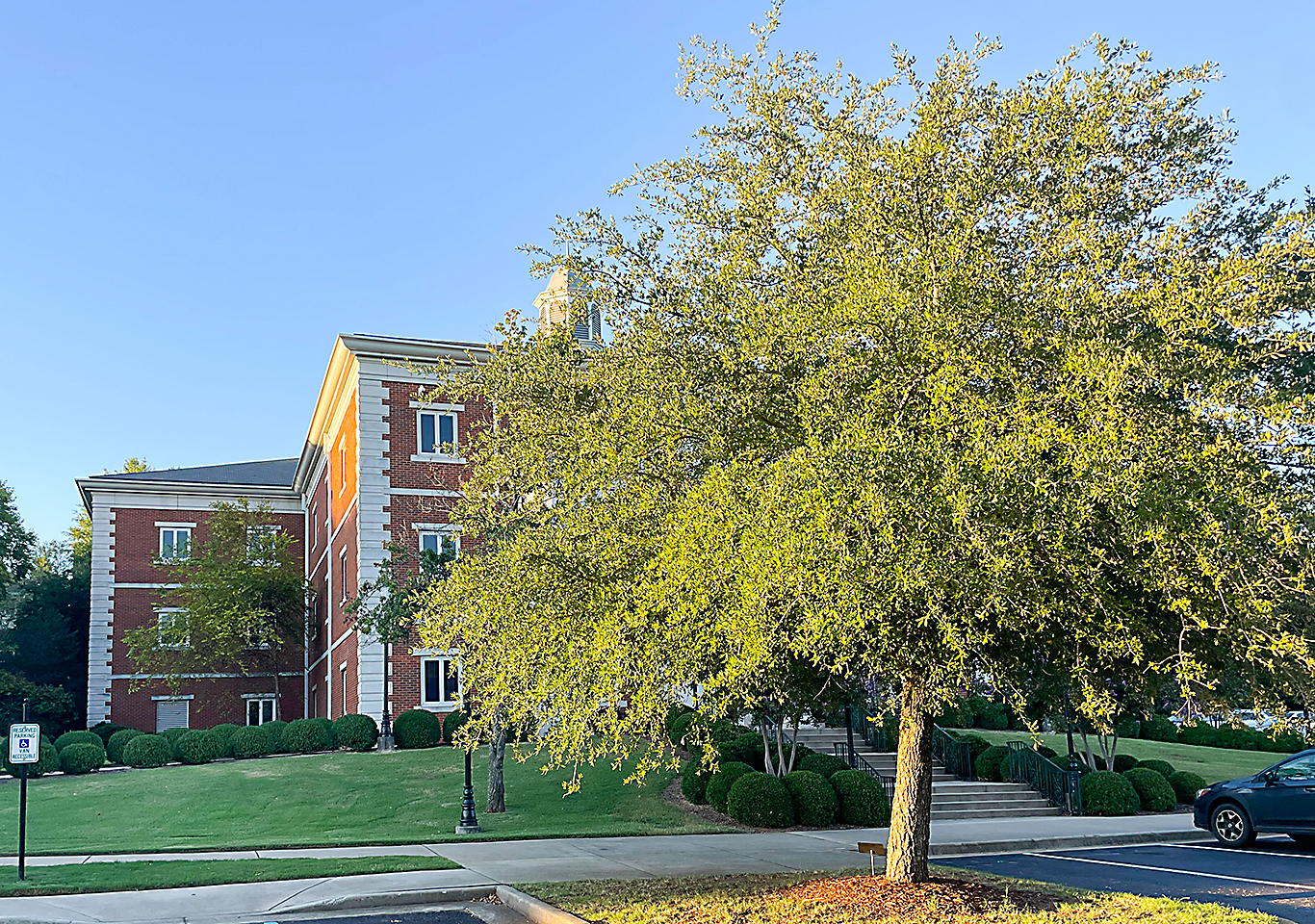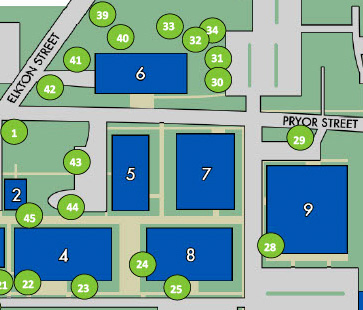
2. Brown Hall
4. Sandridge Student Center
5. Sanders Hall
6. Kares Library
7. Classroom Building
8. Waters Hall
9. Carter Gymnasium
Begin The Tour
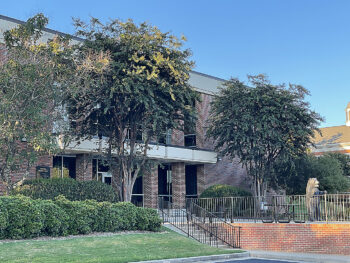 Begin your tour at the Sandridge Student Center. (You can also find out more about the university here.)
Begin your tour at the Sandridge Student Center. (You can also find out more about the university here.)
To the left of the stairs, you will see Williamsburg Golden Rain (22) and to the right of the stairs you will see River Farm Chaste Tree (23.) Continue down the sidewalk to Waters Hall where you will find Angel Live Oak (25) in front of Waters.
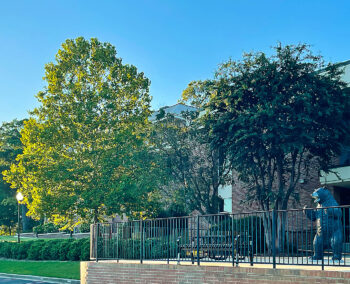 22. Williamsburg Golden Rain (Koelreuteria paniculate)
22. Williamsburg Golden Rain (Koelreuteria paniculate)
Tevin’s Biology Notes: This beautiful tree, originally from China, graces any landscape that it sits upon, with a rare sight in the tree world: Yellow Flowers! Blooming Starts in mid-to-late summer and usually begins three years after planning. The blooms of these trees are also a great way to attract bees, as they seem to love the colorful flowers.
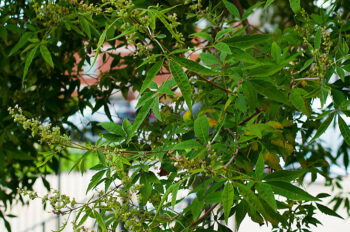 23. River Farm Chaste Tree (Vitex agnus – castus)
23. River Farm Chaste Tree (Vitex agnus – castus)
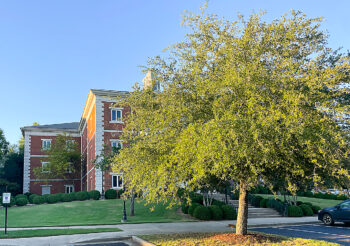 25. Angel Live Oak (Quercus virginiana)
25. Angel Live Oak (Quercus virginiana)
Olivia’s Biology Notes: When grown in open areas, the Southern Live Oak is distinguished by an enormous trunk and great branches originating low on the trunk. A distinct broad crown of simple evergreen or semi-evergreen leaves is characteristic of this common oak of the south. The wood was once so vital to shipbuilding that the United States established the first publicly protected forest to ensure a continuing supply of timber for naval use.
Then turn left between Sandridge Student Center and Waters Hall and up the stairs to see Cyrus Hall McCormick Catalpa (24).
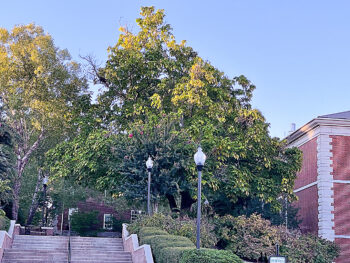 24. Cyrus Hall McCormick Catalpa (Catalpa speciosa)
24. Cyrus Hall McCormick Catalpa (Catalpa speciosa)
Tevins Biology Notes: With heart shaped deciduous leaves, bean like seed pods, and showy flowers, these trees grab the attention of anyone who walks by them. These trees are also the only home to the larvae of the catalpa sphinx moth, a worm that made these trees a popular attraction of anglers. It is said that back in the old times this quality increased property values.
Trivia (The answer to this and other trivia questions can be found at the end of the virtual tour.)
What is a deciduous tree?
Why does the Southern Live Oak tend to adopt a more sprawling growth habit in South Alabama vs North Alabama?
If a tree has large, colorful flowers, like the catalpas, what tends to pollinate them?
If a tree does not have colorful flowers, like the oaks, what tends to pollinate them?
Here you will find Margaret Maples Oliver & Annie Maples Matthews Japanese Maple (44).
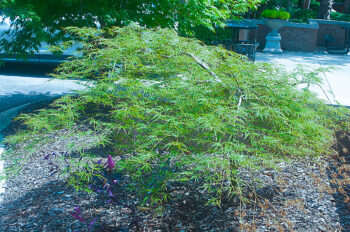 44. Margaret Maples Oliver & Annie Maples Matthews Japanese Maple (Acer palmatum)
44. Margaret Maples Oliver & Annie Maples Matthews Japanese Maple (Acer palmatum)
Olivia’s Biology Notes: Introduced in North America but is native to Japan, China, and Korea. The Japanese maple is widely planted in gardens and parks with at least 1,000 varieties and a wide range of striking characteristics. Variety seen in the leaf shape, color, and overall appearance. The leaves will turn beautiful shades of red, green, orange, pink, and purple.
Then turn right and move toward the Kares Library, passing the Mclntyre Yoshino Cherry Tree (43) on your way.
 43. Mclntyre Yoshino Cherry Tree (Prunus × yedoensis)
43. Mclntyre Yoshino Cherry Tree (Prunus × yedoensis)
Trivia (The answer to this and other trivia questions can be found at the end of the virtual tour.)
Why do you think leaves change colors in the fall?
How can you determine how old a tree is?
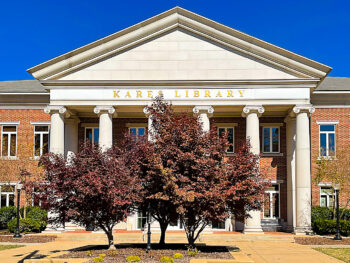 Cross Pryor Street at the crosswalk toward the Kares Library
Cross Pryor Street at the crosswalk toward the Kares Library
To the left and rear of the library where you will find Walden Woods River Birch (39), Helen Keller Water Oak (40), Wilbur and Orville Wright Red Cedar (41), and Williamsburg Silver Maple (42).
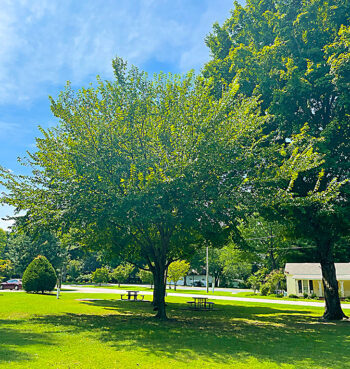 39. Walden Woods River Birch (Betula nigra)
39. Walden Woods River Birch (Betula nigra)
Olivia’s Biology Notes: This small to medium sized tree can have one to several trunks and is characterized by rust colored bark that peels horizontally to reveal cream colored inner bark. The River Birch is the only birch that fruits in the spring and is the most wetland adapted.
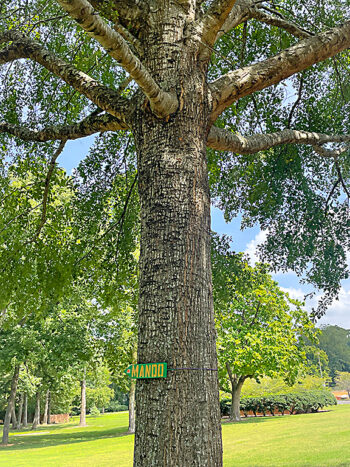 40. Helen Keller Water Oak (Quercus nigra)
40. Helen Keller Water Oak (Quercus nigra)
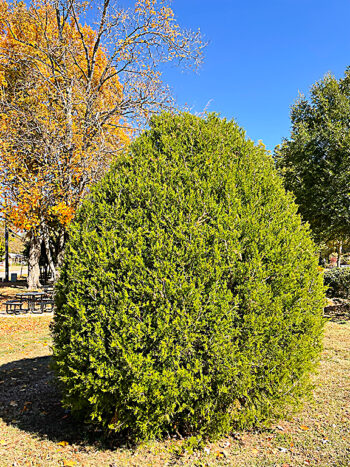 41. Wilbur and Orville Wright Red Cedar (Juniperus virginiana)
41. Wilbur and Orville Wright Red Cedar (Juniperus virginiana)
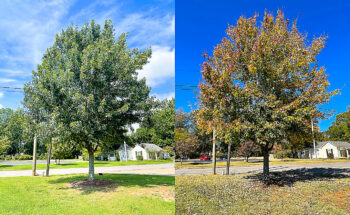 42. Williamsburg Silver Maple (Acer saccharinum)
42. Williamsburg Silver Maple (Acer saccharinum)
Trivia (The answer to this and other trivia questions can be found at the end of the virtual tour.)
What breakfast condiment is made from sap of Maple trees?
What two American transcendentalist writers are associated with the property of Walden? One who owned the property, and one who wrote the book Walden after his stay there.
Where is Helen Keller from?
Where is Helen Keller buried?
Continue behind the library to the right and see Monticello Catalpa (32) and Martin Luther King Jr. Sycamore (33).
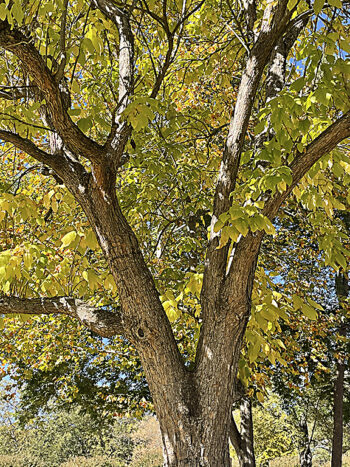 32. Monticello Catalpa (Catalpa speciosa)
32. Monticello Catalpa (Catalpa speciosa)
 33. Martin Luther King Jr. Sycamore (Plantus occidental)
33. Martin Luther King Jr. Sycamore (Plantus occidental)
Tevin’s Biology Notes: You will also notice the large fuzzy balls, the fruit of these amazing trees. Once used as a common shade tree in urban areas, this water tolerant species is now used by environmentalists to appraise wetlands across the U.S.
Trivia (The answer to this and other trivia questions can be found at the end of the virtual tour.)
What church did Martin Luther King Jr. pastor in Alabama?
Why does the bark of a sycamore tree peel?
From here, turn right alongside the library and return to the front of the library. Along the way, notice the Alex Haley Silver Maple (31) and Edgar Allen Poe Hackberry (30).
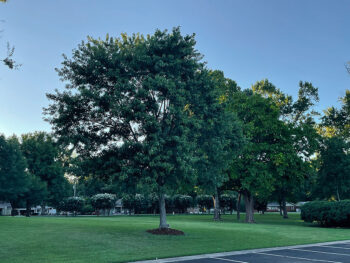 31. Alex Haley Silver Maple (Acer saccharinum)
31. Alex Haley Silver Maple (Acer saccharinum)
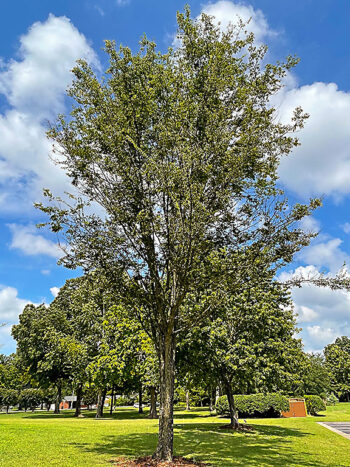 30. Edgar Allen Poe Hackberry (Celtis occidentalis)
30. Edgar Allen Poe Hackberry (Celtis occidentalis)
Tevin’s Biology Notes: Hackberry trees are some of the toughest species of trees found in the U.S. They have a range spreading from southern Canada to Florida and are extremely resistant to disease. The berries produced by this tree are a favorite of winter birds; and the flowers attract dozens of butterfly species.
Trivia (The answer to this and other trivia questions can be found at the end of the virtual tour.)
What genre of short story did Edgar Allen Poe invent?
What is the tough outer bark of a tree composed of?
To continue on to the Carter Gym, Cross Pryor Street, cross it again, and then turn to your left.
After you cross Pryor, turn left and walk to the rear of the Classroom Building then right between the Carter Gym and the Classroom Building. In front of the gym, you will see Jesse Owens Honey Locust (29).
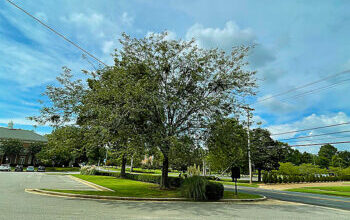 29. Jesse Owens Honey Locust (Gleditsia triacanthos)
29. Jesse Owens Honey Locust (Gleditsia triacanthos)
Olivia’s Biology Notes: The honey locust tree has fascinating compound deciduous leaves. The bell shaped flower appears in late spring to early summer. These trees often display thick clumps of glossy long and branching thorns on the trunk and lower branches.
Continue down the sidewalk alongside the Waters Building. To your left along the wall of the Carter Gym you will see Jesse Owens Water Oak (28).
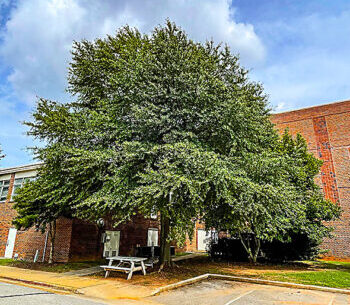 28. Jesse Owens Water Oak (Quercus nigra)
28. Jesse Owens Water Oak (Quercus nigra)
Tevin’s Biology Notes: This tree drops an impressive amount of acorns each fall, which attracts dozens of species of wildlife. It is easy to identify, just look for the oak with the duck foot shaped leaves. We think this one might be mislabeled and is really a willow oak. What do you think?
Trivia (The answer to this and other trivia questions can be found at the end of the virtual tour.)
What are leaves primarily responsible for?
Who is Jesse Owens?
Where is Jesse Owens’ Hometown in Alabama?
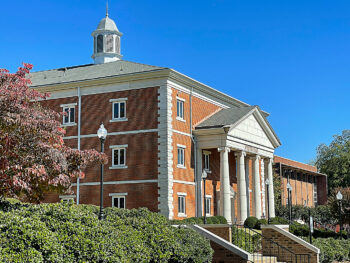 From here you can turn to your right at the front of Waters Hall and return to the parking area in front of Sandridge Student Center.
From here you can turn to your right at the front of Waters Hall and return to the parking area in front of Sandridge Student Center.
We hope you enjoyed your tour. Now check your trivia answers before you go!
What is a deciduous tree?
A deciduous tree sheds all leaves at the end of the growing season and has a dormant period after the growing season.
Why does the Southern Live Oak tend to adopt a more sprawling growth habit in South Alabama vs North Alabama?
In South Alabama the Southern Live Oak tends to adopt a more sprawling growth pattern in South Alabama versus North Alabama because in the colder temperatures the vascular tissue of the tree will freeze.
If a tree has large, colorful flowers, like the catalpas, what tends to pollinate them?
If a tree has large colorful flowers, it will attract bees, butterflies, moths and other pollinators to move pollen from flower to flower.
If a tree does not have colorful flowers, like the oaks, what tends to pollinate them?
Oak trees tend to be wind pollinated.
Why do you think leaves change colors in the fall?
The chlorophyll breaks down and the green color disappears allowing the beautiful fall colors to show.
How can you determine how old a tree is?
You count the growth rings in the bark.
What American transcendentalist writer owned the property of Walden?
Ralph Waldo Emerson owned the property while Henry David Thoreau wrote the book.
Where is Hellen Keller from?
Tuscumbia, Alabama
Where is Hellen Keller buried?
Washington National Cathedral, Washington, D.C.
What breakfast condiment is made from sap of this species of tree? Maple Syrup
What church did Martin Luther King Jr. pastor in Alabama?
Dexter Avenue Baptist Church in Montgomery
Why does the bark of a sycamore tree peel?
The bark cannot accommodate for the fast growth of the trunk and branches.
What genre of short story did Edgar Allen Poe invent?
Detective Fiction
What is the tough outer bark of a tree composed of?
The tough outer bark is composed of dead cells. The living cells that make vascular tissue for transporting nutrients are protected on the inner portion of the tree.
Who is Jesse Owens?
He won four gold medals in the 1963 Olympics.
Where is Jesse Owens’ Hometown in Alabama?
Oakville, Alabama
What are leaves primarily responsible for?
To produce food for the plant by photosynthesis
Original Tree Tour by Tevin Terry
Virtual tour, additional biology notes, and trivia by Olivia Rizzo.
Photography by Nicholas Rizzo and Stephen Rizzo.
